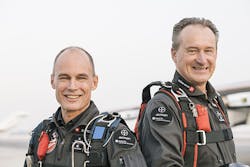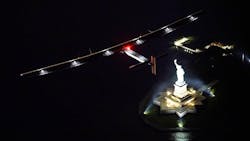The fuel-free Solar Impulse, which we have reported on extensively, landed in Cairo International Airport in Egypt last week. This will be the last flight of CEO and co-founder André Borschberg. “This flight across Europe will touch a large number of countries, very diverse in terms of culture, climate and geography,” says Borschberg. “But in addition to all being on the shore of the Mediterranean Sea, they have a common denominator: the potential benefit of using renewable energies and clean technology.”
“After 36,000 km, people might start to find it obvious to fly day and night without fuel, but it’s still a very difficult endeavor and the challenge will remain open until the last minute,” added Bertrand Piccard, initiator, chairman, and pilot.
Despite the challenges and the difficulty of flying the plane itself, the team is dedicated to sharing the journey. They have 10 live cameras in the cockpit and often conducting interviews live while in flight. You can see their journey at http://www.solarimpulse.com/.
Update: Currently, the plane is delayed for the weather, and unfortunately pilot health, before it can complete its record-breaking journey from Egypt to Dubai. The team is expected to leave any day. Once they depart, they expect the final flight will take 48 to 72 hours and bring an end to the historic journey.
Bertrand Piccard’s vision of achieving a perpetual flight with zero fuel was a result of the round-the-world balloon flight that he accomplished in 1999 with Brian Jones. At the time, they left with 3.7 tonnes/~8.200 lb. of propane and finished with just 40 kg/ ~88 lb. left upon arrival. When Piccard realized that their attempt could have failed for lack of fuel, he promised himself to fly around the world again, but next time without using any fossil fuels. Following a feasibility study carried out by the EPFL (the Swiss Federal Institute of Technology in Lausanne) and led by André Borschberg, the Solar Impulse project was officially launched in 2003.
Solar Impulse started off with the vision of building an airplane capable of flying night and day without using any fuel, propelled solely by solar energy. The aim of the project was to develop a symbol which would attractively promote a pioneering and innovative spirit, particularly in the field of renewable energy and clean technologies.
Here are some highlights from our recent conversation with both men and Alexandra Gindroz, Head of Media Relations at Solar Impulse:
What were some of the design considerations and challenges for this airplane (wing design, motors, batteries, weight, materials, fasteners, etc.)?
Gindroz: Probably the extent to which we had to think out of the box in terms of technology and go look for the necessary knowledge elsewhere. After the feasibility study we went to many airplane constructors with the idea that they could build the airplane, but they all answered that the project was impossible and that they didn’t have the appropriate technology. We therefore had to build our own specific and diversified team responsible for designing Solar Impulse. For example, we ended up turning to a company that normally designs and builds boats, and a Swiss company called Decision specializing in composite structure and carbon fiber, to build the structure of the airplane.
Additionally, there were two very distinct difficulties. Firstly, the fact that we had to start from scratch in a new domain—as with every pioneering project, when you are the first to try to develop or apply a new method, it is always hard not having a benchmark. Secondly, the design of the plane itself—in order to fly day and night with zero fuel powered by solar energy alone and accomplish a round the world flight, the team had to come up with new solutions, pushing back the limits of technology in many different fields. From the beginning, we knew that the plane would require a large wingspan to reduce drag and a large surface to insert enough solar cells and produce sufficient energy (269.5 m2), whilst at the same time have an ultra-light structure to save a maximum amount of energy and fly throughout the night on batteries. The result is breathtaking: Solar Impulse has a wingspan that is wider than a Boeing 747 (72 m), the weight of an empty family car (2,300 kg), and the average 24 horsepower of a small motorbike (15 hp).
How does Solar Impulse handle compare to other aircrafts?
Piccard: With a normal airplane, you learn to pilot with dual controls. However, that is not possible on Solar Impulse, which is a single seater. You can only learn on the ground in a simulator by observing and talking with the test pilot. When you find yourself in the air for the first time, when you’re really flying, nobody is there at your side to correct you. Plus, you know that this is the only airplane in the world like this so you can’t break it! In terms of piloting, it is not an easy airplane. Its lightness and slowness make it very sensitive to the slightest turbulence. It behaves like a large microlight except that the disproportionate scale creates a lot of inertia. The reaction time for controls is therefore very long with the risk of over correcting and inducing oscillations.
Borschberg: The beauty of Solar Impulse is the more we fly, the more energy we collect.
It’s clear that you consider Solar Impulse to be more than just a plane. Can you elaborate?
Piccard: Indeed, Solar Impulse was not built to carry passengers, but to carry messages. What we can achieve in the air, anyone can do on the ground. Let’s replace old polluting devices with modern and efficient technologies. Our world needs to find new ways of improving the quality of human life. Clean technologies and renewables are part of the solution.
What is on the line if you fail, and where do you go after you succeed?
Gindroz: First of all, the round-the-world flight is not a race against time. We are approaching the end of the match but we still have to win the last legs of this adventure. Additionally, if the impossible were easy, everyone would have done it already. It can therefore take many attempts. This was true of the first round-the-world non-stop balloon flight performed by Bertrand Piccard: the first two attempts failed and he had to try a third time to succeed. Our philosophy remains the same for Solar Impulse, but we are confident we will be able to accomplish the rest of the journey by the end of this summer. However, the adventure will not end as Solar Impulse lands back in Abu Dhabi; it will be only the beginning.



